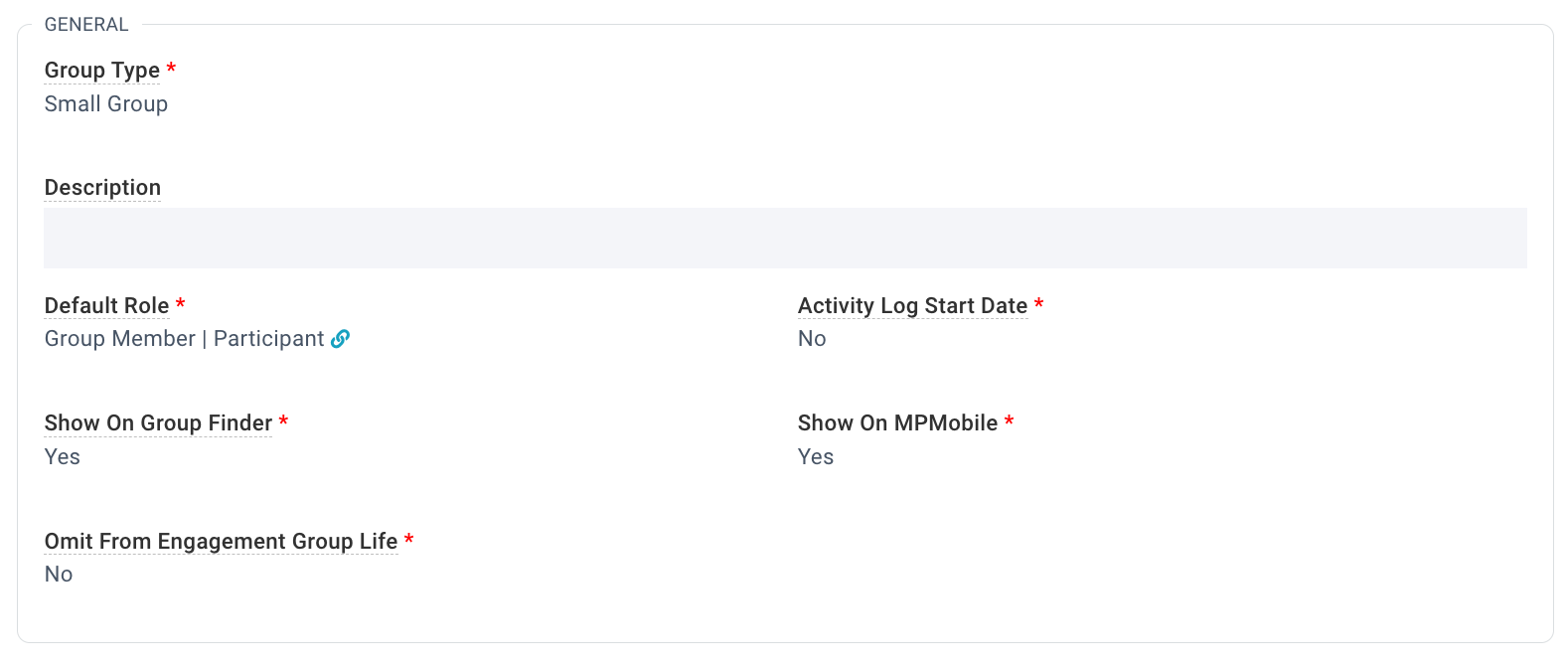
In order to use Groups and Group Participants, there is some initial one-time setup that a SPoC can do with applicable ministry staff.
Define Group Types
Group Types are the general categories that a Group falls within. Several Group Types came standard with your system, and are hard-coded into parameters in use by applications that use the API. The default Group Types are:
Small Groups: Made up of people who meet regularly. In some churches, these groups may be mutually exclusive (cell groups). Use the Group Finder page on the Portal to help people find these groups. Teach leaders to manage their group members with the My Groups page of the Portal.
Age or Grade Groups: Made up of people (generally children or youth) who are the same age or in the same grade at school. There are generally be many people in each of these groups. A single "1st Grade" Group can serve a church regardless of size. Most churches can then use these Groups to secure children's check-in across all worship services and all campuses.
Ministry Teams: Made up of people who serve together, at the same time and/or under the same leader. These Groups are generally small and there should be as many of them as needed for communication and accountability. Ministry Teams should have people with different Group Roles (see below) in them.
Mission Trip: Groups of this type exist to allow mission trip leaders to leverage the My Groups page of the Public Portal.
Class: Made up of at least one teacher and one or more students. These groups are generally short-term in purpose and they may be used in combination with a Program that has a series of events. Churches that do traditional Sunday School may use this group type for the classes.
Parent Group: Parent Groups may be created strictly to organize other groups. A Parent Group of "Elementary" may assist in organizing the primary school grades. This Group name becomes a label organizing the groups on summary reports.
Small Group Area: A special type of parent group that will appear as an option for searching in the Group Finder on the Portal.
Small Group Request: A rarely used Group Type that indicates a Group that someone suggested through the Suggest a Group page of the Portal.
You can create additional Group Types in Lookup Values. If you want to delete any of the standard Group Types, contact Support before doing so to ensure none of the hard-coded information is affected.
Group Type Fields

- Group Type*: A friendly name for the Group Type.
- Description: A brief description of the Group Type.
- Default Role*: The Group Role that will default for new Participants added to Groups with this Group Type if no other Group Role is defined.
- Activity Log Start Date: If true, being in a Group is a good indicator of whether a person is active and will update the Activity Log.
- Show On Group Finder*: If true, Groups with this Group Type will appear on the Portal Group Finder.
- Show On MPMobile*: If true, Groups with this Group Type will appear on MinistryPlatform Mobile.
- Omit From Engagement Group Life: If true, this Group Type will not be considered by the Participant Engagement routine.
Define Group Roles
A Group Role is a position or job that someone in your church might be assigned. It is the manner in which the individual group member relates to the group itself. For example, a Group Type of Class may have teachers, helpers and students.
You can define as many Group Roles as needed to reflect the language used to denote different ministry positions. New Group Roles are managed on Church Structure > Group Roles. When creating a Group Role, note that the field Direction field (Inward, Outward) has no real definition; you can define how those roles work for your church. Pro tip: Group Roles shouldn't imply time period or status (for example, "2020 Ushers" or "Inactive Ushers").
There are two approaches to creating Group Roles:
- Consolidated List: Utilize the same 7-10 group roles throughout ministries. Each role is clearly defined for the type of participant it should be assigned to. This enables ministry leaders to all to speak the same language and allows for all those looking at the data to easily identify which participants are doing what in each group. This approach also allows for easy searches on the Group Participants page and views to be easily created for each role.
- Expanded List: Utilizes a myriad of roles. Each ministry can work with their church's SPoC and develop roles that work for their various groups. In this approach, it is important to utilize the role type and ensure that each role that is created is assigned to the appropriate type in order to classify participants for views. One benefit of the expanded list approach? You can create fewer groups with more group roles and having fewer groups makes it easier for the basic user to communicate with their groups and run reports.
But whichever approach you chose, it's important that you assign Group Roles consistently. The decision about whether a specific role should be given the type Servant or Leader should be made based upon a church-wide policy. For example, one church may consider a deacon a servant while another church may consider a deacon to be a leader. The youth pastor may consider the kids who play in the youth band to be leaders in his ministry, but the church may not agree that those jobs rise to the level of leadership. A simple definition of Group Role Types assist in clarifying things, for example:
Leader: Oversees those who serve.
Servant: Ministers to others.
Participant: Receives ministry from servants and leaders.

